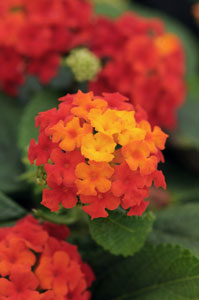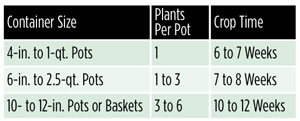5/29/2015
Real Series: Little Lucky Lantana
Ryan Hall

Nothing says summer like hot days, warm nights and a baseball game playing in the background. It’s a great time of year filled with activities that bring people together in their gardens to relax and entertain. Keeping the summer garden in color creates an opportunity to use new plants that not only survive, but thrive, in the heat. Summer also creates a great opportunity to refresh with summer-focused combinations, which are easy to grow and simple to use on the patio or porch. This gives the consumer a great option to both extend their gardening into the summer season, as well as give them easy options that don’t require a lot of time to keep their gardens looking great.
One item that fits perfectly in the summer garden and especially in combos is Little Lucky Lantana. Little Lucky is notably more compact than what most consumers are used to with lantana. Little Lucky holds its shape in a dense mound, making it ideal for combo planters, where it adds a pop of bright color and won’t overtake other items. Consumers who are used to spreading, gangly habits of traditional lantana will find Little Lucky to be a refreshing new option when looking to create their summer landscapes and containers. Little Lucky is available in six vibrant colors, including a bold red and hot pink.
Growers will find Little Lucky to be a refreshing option as well. Little Lucky is extremely uniform across all colors, making the series a snap to produce in packs and 1-qt. pots. Little Lucky’s uniformity makes it one of Ball FloraPlant’s “Real Series” group of plants. The Real Series designation means Little Lucky is a sure bet for production planning, guaranteeing all colors will be ready and flowering within the same week and can be produced with the same culture. Growers can be confident with Little Lucky that they have a Real Series that’s easy to produce and will ship to market at the same time for a big impact at retail.
Most growers and consumers are used to more vigorous, poorly branched lantana. However, Little Lucky is quite different in its overall habit and culture. Growers should approach Little Lucky differently, especially when it comes to growth regulators. Follow these tips to produce the best Little Lucky Lantana for your customers.
 Crop time: Rooted liner to finish
Crop time: Rooted liner to finish
Lantanas are moderately quick growers, especially when grown in the warm temperatures of summer.
Media & pH
Plant well-branched liners into a well-drained media. Peat-based or peat/perlite-based soil mix is ideal; however, lantana are resilient growers and tolerate a range of soil types. Avoid overly saturated media, as this can cause root rot. Allow the media to dry in between waterings. Little Lucky should be grown under a standard bedding plant pH regime targeting a pH between 5.8 to 6.2.
Temperatures
Little Lucky are heat lovers and appreciate warm temperatures in production. Growing lantana too cold will result in slower growth and leaf chlorosis. Ideal day temperatures are from 71 to 79F (21 to 26C), with ideal night temperatures from 62 to 67F (16 to 19C).
Light levels
Little Lucky are full-sun plants and should receive high levels of light during production. Minimum recommendations for light would be 5,000 f.c. with the high end of 10,000 f.c. Often one will compromise flowering and have excessive vegetative growth when light levels are too low, especially when combined with over-fertilization.
Fertilizer
Little Lucky are moderate feeders and should be grown with a nitrate-based feed at a rate of 225 to 300 ppm N. Avoid ammoniacal-based feeds, as this can promote excessive vegetative growth. Growers should watch for salt build-up, as this can lead to foliage necrosis. Low amounts of feed can result in poor overall branching.
PGRs
Little Lucky are naturally compact and shouldn’t require any growth regulators. Providing Little Lucky with a pinch, high light, warm temperatures and moderate feed will give you the best overall quality of growth and flowering. If more control is desired, B-Nine is effective at rates between 2,000 to 3,000 ppm applied 7 to 10 days after pinching.
Pests & diseases
Lantana’s pubescent foliage makes it a magnet for whitefly. Regular scouting and preventative IPM controls are best used to stay ahead of whitefly outbreaks. Aphids and leafminer can also be problematic with lantana; proper scouting sanitation is the best defense against problematic pests.
GT
Ryan Hall is Product Manager for Ball FloraPlant, stationed in Arroyo Grande, California.